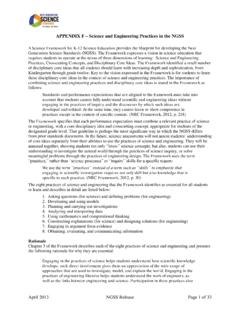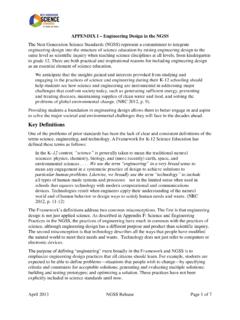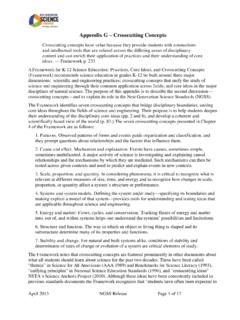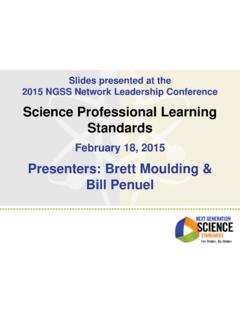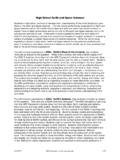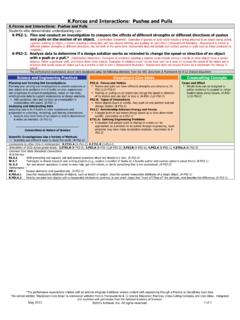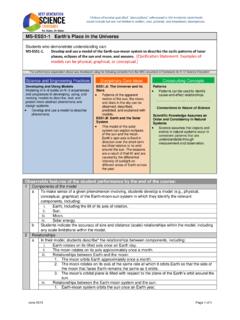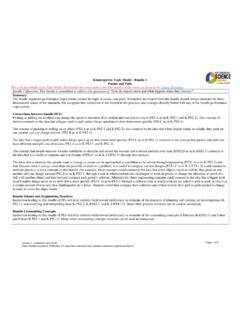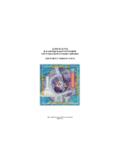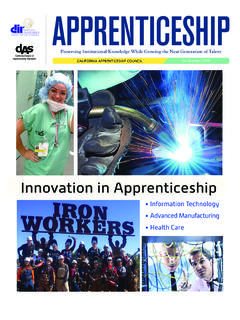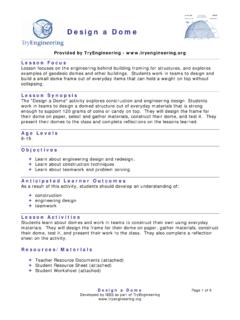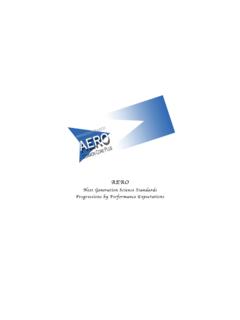Transcription of APPENDIX F Science and Engineering Practices in …
1 April 2013 NGSS Release Page 1 of 33 APPENDIX F Science and Engineering Practices in the NGSS A Science Framework for K-12 Science Education provides the blueprint for developing the next Generation Science Standards (NGSS). The Framework expresses a vision in Science education that requires students to operate at the nexus of three dimensions of learning: Science and Engineering Practices , Crosscutting Concepts, and Disciplinary Core Ideas. The Framework identified a small number of disciplinary core ideas that all students should learn with increasing depth and sophistication, from Kindergarten through grade twelve. Key to the vision expressed in the Framework is for students to learn these disciplinary core ideas in the context of Science and Engineering Practices . The importance of combining Science and Engineering Practices and disciplinary core ideas is stated in the Framework as follows: Standards and performance expectations that are aligned to the framework must take into account that students cannot fully understand scientific and Engineering ideas without engaging in the Practices of inquiry and the discourses by which such ideas are developed and refined.
2 At the same time, they cannot learn or show competence in Practices except in the context of specific content. (NRC Framework, 2012, p. 218) The Framework specifies that each performance expectation must combine a relevant practice of Science or Engineering , with a core disciplinary idea and crosscutting concept, appropriate for students of the designated grade level. That guideline is perhaps the most significant way in which the NGSS differs from prior standards documents. In the future, Science assessments will not assess students understanding of core ideas separately from their abilities to use the Practices of Science and Engineering . They will be assessed together, showing students not only know Science concepts; but also, students can use their understanding to investigate the natural world through the Practices of Science inquiry, or solve meaningful problems through the Practices of Engineering design.
3 The Framework uses the term Practices , rather than Science processes or inquiry skills for a specific reason: We use the term Practices instead of a term such as skills to emphasize that engaging in scientific investigation requires not only skill but also knowledge that is specific to each practice. (NRC Framework, 2012, p. 30) The eight Practices of Science and Engineering that the Framework identifies as essential for all students to learn and describes in detail are listed below: 1. Asking questions (for Science ) and defining problems (for Engineering ) 2. Developing and using models 3. Planning and carrying out investigations 4. Analyzing and interpreting data 5. Using mathematics and computational thinking 6. Constructing explanations (for Science ) and designing solutions (for Engineering ) 7. Engaging in argument from evidence 8.
4 Obtaining, evaluating, and communicating information Rationale Chapter 3 of the Framework describes each of the eight Practices of Science and Engineering and presents the following rationale for why they are essential. Engaging in the Practices of Science helps students understand how scientific knowledge develops; such direct involvement gives them an appreciation of the wide range of approaches that are used to investigate, model, and explain the world. Engaging in the Practices of Engineering likewise helps students understand the work of engineers, as well as the links between Engineering and Science . Participation in these Practices also April 2013 NGSS Release Page 2 of 33 helps students form an understanding of the crosscutting concepts and disciplinary ideas of Science and Engineering ; moreover, it makes students knowledge more meaningful and embeds it more deeply into their worldview.
5 The actual doing of Science or Engineering can also pique students curiosity, capture their interest, and motivate their continued study; the insights thus gained help them recognize that the work of scientists and engineers is a creative endeavor one that has deeply affected the world they live in. Students may then recognize that Science and Engineering can contribute to meeting many of the major challenges that confront society today, such as generating sufficient energy, preventing and treating disease, maintaining supplies of fresh water and food, and addressing climate change. Any education that focuses predominantly on the detailed products of scientific labor the facts of Science without developing an understanding of how those facts were established or that ignores the many important applications of Science in the world misrepresents Science and marginalizes the importance of Engineering .
6 (NRC Framework 2012, pp. 42-43) As suggested in the rationale, above, Chapter 3 derives the eight Practices based on an analysis of what professional scientists and engineers do. It is recommended that users of the NGSS read that chapter carefully, as it provides valuable insights into the nature of Science and Engineering , as well as the connections between these two closely allied fields. The intent of this section of the NGSS appendices is more limited to describe what each of these eight Practices implies about what students can do. Its purpose is to enable readers to better understand the performance expectations. The Practices Matrix is included, which lists the specific capabilities included in each practice for each grade band (K-2, 3-5, 6-8, 9-12). Guiding Principles The development process of the standards provided insights into Science and Engineering Practices .
7 These insights are shared in the following guiding principles: Students in grades K-12 should engage in all eight Practices over each grade band. All eight Practices are accessible at some level to young children; students abilities to use the Practices grow over time. However, the NGSS only identifies the capabilities students are expected to acquire by the end of each grade band (K-2, 3-5, 6-8, and 9-12). Curriculum developers and teachers determine strategies that advance students abilities to use the Practices . Practices grow in complexity and sophistication across the grades. The Framework suggests how students capabilities to use each of the Practices should progress as they mature and engage in Science learning. For example, the practice of planning and carrying out investigations begins at the kindergarten level with guided situations in which students have assistance in identifying phenomena to be investigated, and how to observe, measure, and record outcomes.
8 By upper elementary school, students should be able to plan their own investigations. The nature of investigations that students should be able to plan and carry out is also expected to increase as students mature, including the complexity of questions to be studied, the ability to determine what kind of investigation is needed to answer different kinds of questions, whether or not variables need to be controlled and if so, which are most important, and at the high school level, how to take measurement error into account. As listed in the tables in this chapter, each of the eight Practices has its own progression, from kindergarten to grade 12. While these progressions are derived from Chapter 3 of the Framework, they are refined based on experiences in crafting the NGSS and feedback received from reviewers. Each practice may reflect Science or Engineering .
9 Each of the eight Practices can be used in the service of scientific inquiry or Engineering design. The best way to ensure a practice is being used April 2013 NGSS Release Page 3 of 33 for Science or Engineering is to ask about the goal of the activity. Is the goal to answer a question? If so, students are doing Science . Is the purpose to define and solve a problem? If so, students are doing Engineering . Box 3-2 on pages 50-53 of the Framework provides a side-by-side comparison of how scientists and engineers use these Practices . This chapter briefly summarizes what it looks like for a student to use each practice for Science or Engineering . Practices represent what students are expected to do, and are not teaching methods or curriculum. The Framework occasionally offers suggestions for instruction, such as how a Science unit might begin with a scientific investigation, which then leads to the solution of an Engineering problem.
10 The NGSS avoids such suggestions since the goal is to describe what students should be able to do, rather than how they should be taught. For example, it was suggested for the NGSS to recommend certain teaching strategies such as using biomimicry the application of biological features to solve Engineering design problems. Although instructional units that make use of biomimicry seem well-aligned with the spirit of the Framework to encourage integration of core ideas and Practices , biomimicry and similar teaching approaches are more closely related to curriculum and instruction than to assessment. Hence, the decision was made not to include biomimicry in the NGSS. The eight Practices are not separate; they intentionally overlap and interconnect. As explained by Bell, et al. (2012), the eight Practices do not operate in isolation. Rather, they tend to unfold sequentially, and even overlap.
